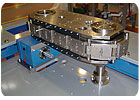
With a carousel conveyor, engineers can locate assembly stations along both sides of the machine. Photo courtesy CDS Corp.
Fortunately, assemblers can get the speed, precision and durability of a rotary dial in linear form: a precision-link indexing conveyor. The conveyor consists of precision-machined plates, or pallets, linked together in a chain like tank treads. The chain rides in tracks between two large sprockets. Roller bearings enable the plates to move smoothly along the tracks and to pivot as they move around the sprockets. Part fixtures are mounted directly to the plates, which can be cast iron, steel or aluminum. Aluminum plates are lighter and less expensive, but can stretch over time in high-speed applications.
The conveyor can be built in over-under or carousel configurations. In the former, the plates are parallel with the floor; in the latter, they’re perpendicular. “Obviously, with an over-under conveyor, you can only work on the top pallets,” says Rob Zaruba, president of CDS Corp. (Sparta, NJ). “So an over-under configuration is more suited to processes, like pressing or screwdriving, that may put a little more force onto the conveyor.
“With a carousel conveyor, you can have assembly stations along both sides of the machine. With our conveyor, you can even use the radiused ends for assembly stations. [Given] the price of a precision-link conveyor, you want to be able to use as many pallets as possible.”
The conveyors are available in many sizes. For example, a modular, tabletop system from De-Sta-Co’s Camco Div. (Wheeling, IL) can be built in lengths from 3 to 30 feet. It has a wide, open frame, so pick-and-place units, timing chains and power lines can be located in the center of the machine. Pallets come in standard lengths of 1.5, 2, 3, 4.5 and 6 inches.
At the opposite end of the spectrum, Camco offers a heavy-duty conveyor, with a solid base and heavily ribbed legs to support large loads. The conveyor is offered in standard lengths of 12, 18 and 24 feet. Pallets come in lengths of 6, 9 and 12 inches. It can be built with an open configuration, like the tabletop unit, or with a closed configuration for increased rigidity.
Several suppliers offer indexing conveyors specifically for medical device assembly. For example, the Medi-Cam from CDS has stainless steel or nickel-plated components. It has a closed configuration, and the indexing drive is located inside the machine. Internal Viton seals and o-rings ensure leakproof operation, and only FDA-approved lubricants are applied to the moving parts.
The move-dwell-move motion of the conveyor comes from a globoidal or barrel cam driven by a DC motor. A servomotor can generate the same motion profile without the cam, but cam-driven systems are more durable and efficient. A cam-driven system can index half a pallet length, a full pallet length or double the pallet length. Locking mechanisms, such as shot pins, aren’t needed to locate the pallets.
The conveyor can index continuously, or it can index on a signal from a PLC or a switch activated by an operator. PLC control is a good option if the assembly system will include operations, such as welding, that might take more than 2 seconds to complete.
Depending on the size, speed and design of the system, the conveyor can index as fast as 200 cycles per minute and position pallets with an accuracy of ±0.002 inch. “Most applications aren’t that fast,” says Tony Eyink, president of Sankyo America Inc. (Sidney, OH). “You typically see 60 indexes per minute.”
When specifying a precision-link conveyor, engineers will need to know the total weight of the parts and fixtures; the number of stations; the cycle rate; pallet length; index distance; dwell time; operating environment and accuracy requirements.



